Modernizing Russia’s Cattle and Dairy Sectors under WTO Conditions: Insights from East Germany
Abstract
Martin Petrick — Deputy Head of the Department of External Environment for Agriculture and Policy Analysis, Leibniz Institute of Agricultural Development in Transition Economies (IAMO). Address: 2, Theodor-Lieser St., D-06120, Halle (Saale), Germany. E-mail: petrick@iamo.de
How to revitalize the cattle and dairy sectors under the WTO commitments has emerged as a major policy challenge for the Russian government. This article raises the question whether livestock recovery in East Germany provides any insights that could be of value to current policy makers in Russia. Similar to Russia, livestock numbers plummeted in the first years after the end of central planning. Unlike in Russia, milk output per cow increased spectacularly and almost doubled in a period of 20 years. It is argued that reforms of the institutional environment of agriculture were at least as important for this outcome as the generous availability of funding. Incentives set by financial aid were sometimes unintended, inconsistent, and led to misallocations that were costly to correct later on. More recent capital subsidies were inefficient in reaching any of the manifold goals initially aimed at. While the Russian government may face little difficulty in dressing up its investment subsidies to look like green box compatible, the structural elements of the EU’s Common Agricultural Policy are regarded as a poor guide for policy reform.






